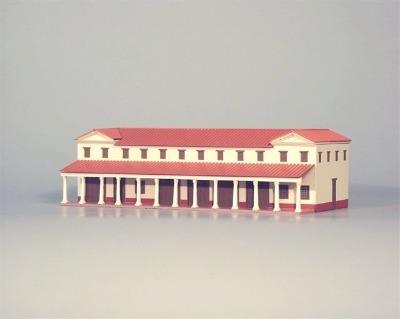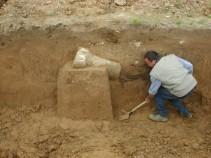Archaeology in Kerkrade in 3D
Archaeology is often not visible to people because the remains are underground. In order to make Kerkrade's residents and visitors aware of the history of their environment and to make it visible and experienceable, the municipal archaeology working group and the Foundation for the Preservation of Small Landscape Elements (IKL) in Limburg conceived the plan to make parts of the invisible past visible through 3D techniques.

In this way, Kerkrade's archaeology is made known in a contemporary appealing way. The goal is to make visitors curious and invite them to request information via digital means. As a trial, the Roman villa site on Krichelstraat has been chosen to be physically upgraded and digitally visualized.
Technology
With digital techniques and using a smartphone, information about the archaeological site can be retrieved. Through added reality, the archaeological remains (e.g., a Roman villa) are made visible. With this technique, the computer-made reconstruction is added to the real images in the most realistic way possible.
On site, the visitor scans a QR code with the smartphone to download an app. The visitor launches the app, points the smartphone's camera at the archaeological remains. The reconstruction of the archaeological site then appears on the smartphone.
- Watch the film Archaeology in Kerkrade in 3D
Villa Krichelberg
The remains of this Roman villa complex are located on the Krichelstraat in Kerkrade. The remains of this villa were investigated by archaeologists in 1936, 1941 and 1950. The reason for the investigations was the presence of large quantities of Roman roof tile fragments on the surface.

A Roman villa had the function of agricultural business. It is a complex of buildings whose most luxurious dwelling house (main building) is now called villa. The complex contains stables, barns and residential buildings. The main building of villa Krichelberg is built of stone and contains a colonnade, corner tower, a bathhouse, remains of floor heating and wall paintings. Remains of coal have even been found. These were used to stoke the fire for the floor heating.
The stone main building has a wooden predecessor built in the middle of the first century. The wooden building burned down and this stone main building was built on the remains at the end of the first century. The building was expanded several times and was inhabited until the end of the 3rd century. The maximum dimensions of the main building are 21.80 m by 51.50 m.
In 2001, the municipality of Kerkrade commissioned Mr. Kees Peterse to produce a reconstruction on paper of the villa. A model of this reconstruction was then made. Some finds made during the excavation of the villa and the model of the villa are on permanent display in the hall of the Town Office.
Reporting archaeological finds
Have you found something you think is an archaeological object? If so, report it to the Parkstad Regional Archaeologist. For information and to fill out the report form, please visit the Thermenmuseum website.